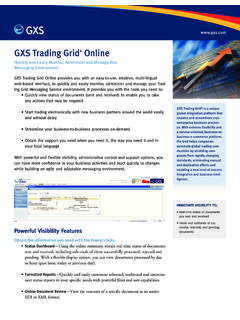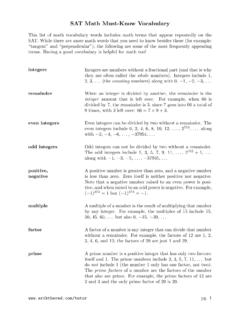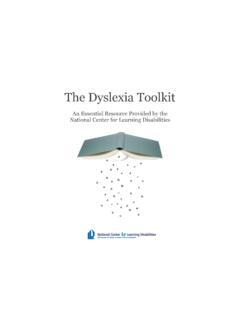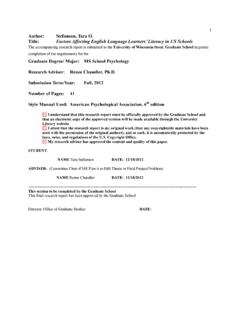Transcription of ANSI ASC X12 Standards Overview Tutorial - GXS Inc.
1 ansi ASC X12 StandardsOverview TutorialLearn About Key e-Commerce Trends and Technologies at Your Own PaceA GXS Special Interest ?.. ASC X12 Standards Overview Tutorial 2 GXS Proprietary and Confidential InformationANSI X12 this Overview provides need-to-know information on the ansi X12 Standards for electronic data interchange (EDI), including transaction sets, data elements and functional Tutorial is an Overview of the ansi ASC X12 Standard topics covered in this module are: Objectives of this Tutorial and how to use it ansi ASC X12 101 some basic information about Standards and ansi Transaction Sets structure, segments, loops, etc. Segments structure, interpretations, conditions, etc. Data Elements what they are and how to use them Message Structure and Enveloping packaging it all Functional Acknowledgments who needs them?
2 How To Use This TutorialThis Tutorial provides basic information about ansi and ansi ASC X12. It should be used as a prerequisite to understanding what ansi ASC X12 is and how ansi ASC X12 is developing Standards to meet the needs of electronic commerce is only the beginning. This Tutorial will introduce terms and concepts that you will find neces-sary to form an awareness of the ansi ASC X12 best way to use this Tutorial is to read through a module and its subtopics, though not necessarily at one sitting. Each module in this Tutorial builds on information presented in earlier modules but an individual subtopic can be used as reference outside of the linear progression of the course. You will find summaries at the end of each module and exercises throughout so you can evaluate your understanding of the send all feedback to Client Training at: ASC X12 Standards Overview Tutorial 3 GXS Proprietary and Confidential InformationTutorial ObjectivesAfter completing this Tutorial , you should be able to discuss: What is ansi and ansi ASC X12 How and why the ansi ASC X12 standard was developed What is the basic structure of the ansi ASC X12 format How ansi ASC X12 documents are read What Functional Acknowledgments are and why are they used How the ansi ASC X12 standard may be used in providing electronic commerce solu-tionsStandards 101 Why Standardize?
3 There are almost as many business computer programs as there are businesses. In the early days, each business had its own programs for tracking merchandise, ordering, invoicing, accounts pay-able, receivable, and other business needs. We soon realized that:The computer programs of one business couldn t talk to those of another which meant that all data that was received would need to be programs in one department of a business couldn t talk to those of another in the same busi-ness order entry couldn t talk to invoicing which couldn t talk to accounts receivable. Required data needed to be re-entered two, three or more answer was to standardize the data that was read by a computer program so that the data could be read by all programs with that standard.
4 Can you read the purchase order below?Human readable purchase order: ansi ASC X12 Standards Overview Tutorial 4 GXS Proprietary and Confidential InformationQuantity Unit Price No. Description 3 CSE 6900 CELLULOSE SPONGES 12 EA .45 P450 PLASTIC PAILS 4 EA .95 1640Y DISH DRAINER 1 DZ 1507 6" FLOWER POTSS tandards translate the human readable invoice to a machine readable format ( ansi X12 ver-sion/release 004010*):*Note: All examples in this Tutorial are based on ansi ASC X12 version/release 004010 unless otherwise notedWhat is a Standard?A standard is a method of coding data to facilitate Electronic Data Interchange (EDI). It provides: Rules of syntax Definition of the data organization Editing rules and conventions Published public documentation ( , a Standards manual) This provides the Standards user with: An open system where trade is possible with anyone who uses the same standard.
5 Reduced implementation effort the implementation of a standard can, itself, be standardized. Third-party interfaces software and network applications can be written that address specific business needs and conform to a single standardWhat is ansi ? ansi ASC X12? ansi is an abbreviation for the American National Standards Institute that has been coordinat-ing Standards in the United States since 1918. ansi offers an open forum for all concerned to identify needs, create plans to meet those needs, and come to an agreement on the proposed Institute has a number of committees including the ansi Accredited Standards Committee X12 ( ansi ASC X12). This committee is a voluntary Standards committee that consists of subcom-mittees representing both private and public sectors in many industries.
6 The subcommittees use a consensus process to propose a new standard or changes to existing Standards . These Standards enable the electronic exchange of business standard that has been recommended by this committee is known as the ansi ASC X12 Standard. It is sometimes called the ansi X12 Standard or simply the X12 *1*3*CA* **VC*6900 N/LIT1*2*12*EA*.457**VC*P450 N/LIT1*3*4*EA*.95**VC*1640Y N/LIT1*4*1*DZ*3**VC*1507 N/LANSI ASC X12 Standards Overview Tutorial 5 GXS Proprietary and Confidential InformationWhat are the X12 Standards ?So, you might ask, what are the X12 Standards ? How do I get them and what do I get? You can order the X12 Standard by contacting: Publications Department Data Interchange Standards Association 7600 Leesburg Pike, Suite 340 Falls Church, VA 22043 Phone: (703) 970-4480 FAX: (703) 970-4488 e-mail: Internet: will receive the X12 Standards manual that includes: Transaction Set Tables Transaction Sets are commonly used business transactions (PO, Invoice, etc.)
7 They are made up of Segments which are made up of Data Elements. Segment Directory A listing of all possible segments. Data Element Dictionary A definition for all possible data elements. Code Sources ansi ASC X12 allows industry-specific codes. These codes are not main-tained by the ansi ASC X12 committee, but by industry organizations. A list of where to obtain these industry codes can be found in the ASC X12 Standards manual. Interactive Control Structure These are syntax rules at the application level that have been agreed upon by the United Nations Economic Commission for Europe (UN/ECE) for Electronic Data Interchange for Administration, Commerce, and Transport (EDIFACT).What is a Transaction Set?A Transaction Set is a single business document such as a Purchase Order, Invoice, or Shipment Notice.
8 There are hundreds of Transaction Sets available in the ansi ASC X12 Standards . Each set of transaction data is identified by a three digit code ASC X12 Standards Overview Tutorial 6 GXS Proprietary and Confidential InformationShip Notice856 Invoice810 Purchase Order850 StructureMany Transaction Sets have three parts. The segments that may be used in each of these parts, within a specific document ( , invoice), are specified in associated tables defined in the X12 Standards document. For example:Segments and SequenceThe tables show which segments may be used in a Transaction Set and the required sequence of the segments. For example, the Purchase Order Transaction Set table shows:Beginning and EndingTransaction Sets: Begin with the Transaction Set Header (ST) segment.
9 End with the Transaction Set Trailer (SE) segment ansi ASC X12 Standards Overview Tutorial 7 GXS Proprietary and Confidential 1 The Header AreaTable 2 The Detail AreaTable 3 The Summary AreaID TITLEST Transaction Set HeaderBEG Beginning Segment for Purchase OrderCUR CurrencyREF Reference IdentificationPER Administrative Communications ContractTAX Tax ReferenceFOB Related InformationCTP Pricing InformationPAM Period AmountCSH Sales RequirememntsTC2 two segments are the innermost level of the three levels of envelopes within the 850 Pur-chase is discussed later in this SegmentsMany Transaction Sets have a unique beginning segment that immediately follows the ST seg-ment. Here are a few examples of transaction sets that contain unique beginning segments: Transaction Set: ---------------- Beginning Segment: Purchase Order ----------------- 850 BEG Segment Price/Sales Catalog ----------- 832 BCT Segment Ship Notice ---------------------- 856 BSN SegmentTransaction Set Segment Requirements DesignationThe standard provides a requirements designator for each segment.
10 The requirements designator indicates if the segment is required, optional or At least one occurrence must appear in the Transaction May be used if Floating segment that may appear anywhere in the transaction set between the ST and SE segments (valid in Standard version/releases 003060 and earlier).MAX UseThe Transaction Set table shows specific attributes of a segment. The MAX use column of the segment detail table shows how many times you may repeat a particular segment at its location in the transaction. This example is for an 850 Purchase ASC X12 Standards Overview Tutorial 8 GXS Proprietary and Confidential FIRST SegmentSUMMARYP urchase OrderThe LAST SegmentLoopsLoops show how a specified group of segments (two or more segments) may repeat in a Transaction example of a loop is the N1 (Name and Address) loop within table 1 of the Purchase Order.









